Mon 27 Jun 2011
PRIME TIME SUSPECTS Part 4.0: Themes and Strands (1950s Police Dramas).
Posted by Steve under Columns , TV mysteries[12] Comments
by TISE VAHIMAGI
Part 4.0: Themes and Strands (1950s Police Dramas)
The American TV police procedural and the British TV senior police detective drama of the 1950s were never the high watermark of the small-screen genre, but their influence on the formats and styles of following crime series lasted for decades.
For instance, the roots of Stephen Bochco’s highly-influential Hill Street Blues (NBC, 1981-87) or the James Arness seen-it-all-before cop series McClain’s Law (NBC, 1981-82) may be traced back to Jack Webb’s 1950s Dragnet.
Likewise, the British police dramas of the 1970s — such as New Scotland Yard (ITV, 1972-74), The Sweeney (ITV, 1975-76; 1978), even the North of England-located Strangers (ITV, 1978-82) — may trace their heritage back to the TV Scotland Yard detective stories of some twenty years earlier.
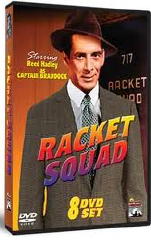
The following, therefore, is simply an overview of two significant phases in the history of the TV Crime & Mystery genre.
The Story You Are About To See (USA: 1950 to 1959). In 1950, Senator Estes Kefauver established a Senate committee to Investigate Crime in Interstate Commerce. It became known as the Kefauver Committee. Its New York hearings were televised to an enormous audience, who witnessed a parade of the most notorious American gangsters treat the Committee with utter disdain.
The TV viewers, naturally, were hungry for more, and TV fed them with Treasury Men in Action (ABC, 1950; 1954-55; NBC, 1951-54), a dramatization of true cases about counterfeiters and gangsters in U.S. Treasury files, and actual cases from police files in Racket Squad (CBS, 1951-53), with Reed Hadley starring and sometimes narrating in the role of a police captain.
In 1951 came Crime Syndicated from CBS (1951-53) offering dramatizations of actual cases from the Kefauver hearings. Rudolph Halley, former chief counsel for the Senate crime investigations, fronted the series. December 1951 saw the advent of Dragnet (NBC, 1951-59; 1967-70). The TV child of actor Jack Webb, who produced, directed and starred in the series, Dragnet soon became not only the most popular show on US television during the 1950s but changed the face of the TV genre forever.
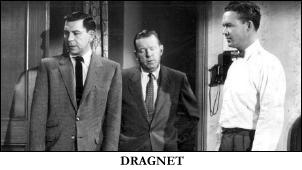
Perhaps the first ever police procedural on TV, Dragnet was a highly stylized but thoroughly enjoyable collection of statistics (time, location, weather), police jargon, and the general drudgery of everyday police work. The stories were borrowed from the files of the LAPD. The relentless questioning of witnesses overshadowed any rare instances of gunplay. The episodes concluded with an update of the criminal’s fate.
In short, Dragnet was one of the most remarkable programs of its era. Webb and his Mark VII Productions went on to produce some of TV’s most successful procedural series (Adam-12, O’Hara U.S. Treasury, Emergency!).
Law enforcement procedurals (‘based on the files of…’) soon gathered momentum, then flooded the small-screen (until the ‘adult’ Western genre arrived). Police anthology Gangbusters (NBC, 1952) was followed hotly by Police Story (CBS, 1952), City Detective (syndicated 1953-55) and The Man Behind the Badge (CBS, 1953-54).
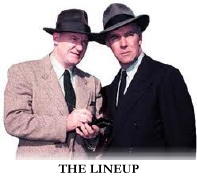
Legal procedurals also came into play, with Public Defender (CBS, 1954-55) and Justice (NBC, 1954-56), the latter from stories based on the files of the Legal Aid Society.
One of the more notable police procedurals of the period was The Lineup (CBS, 1954-60). The drama starred Warner Anderson and Tom Tully as a detective partnership and was produced in cooperation with the San Francisco P.D. The Lineup was CBS’ answer to the highly successful Dragnet on NBC. Nevertheless, as a taut, well-written, filmed series, it stood its ground firmly (in its semi-documentary fashion).
Multiple other ‘based on the files of..’ series filled out the decade, among them (their titles being self-explanatory): The Mail Story (ABC, 1954), Paris Precinct (ABC, 1955), Highway Patrol (syndicated 1955-59), State Trooper (syndicated 1956-59), The Tracer (syndicated 1957-58), based on the files of Tracer Co. of America (N.Y.), Official Detective (syndicated 1957-58), from stories in the title magazine, Harbor Command (syndicated 1957-58), a sort of Dragnet in a nautical setting, and U.S. Border Patrol (syndicated 1959).
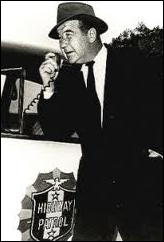
Scotland Yard’s War on Crime (UK: 1954 to 1965). The British view of the Law and its various mechanisms, especially concerning Scotland Yard, was seen at first through a series of BBC documentaries and drama-documentaries (TV reconstructions) that extolled the virtues of the British police and legal services.
For instance, Murder Rap (1947), from Scotland Yard casebooks, Armed Robbery (1947), based on real-life Scotland Yard cases, It’s Your Money They’re After (1948), concerning post-war black marketeers, and War on Crime (1950), a series virtually celebrating ‘from the files of…’ Scotland Yard.
At this time, it dawned on BBC Television that the perceived glamour of ‘Scotland Yard’ was an exportable commodity.
The Oct-Nov 1951 drama-documentary series I Made News, a dramatization of a criminal who had made the UK news that week, was the first to introduce the real-life character of Detective Superintendent Robert Fabian, head of Scotland Yard’s famed Flying Squad (the Cockney rhyming slang was ‘The Sweeney,’ as in Sweeney Todd).
The drama series Fabian of the Yard (BBC, 1954-57), filmed by Trinity Productions/Antony Beauchamp Productions for BBC, became as popular and as influential to the British TV genre as Jack Webb’s Dragnet (NBC, 1951-59) had been, in its way, to the 1950s American TV genre.
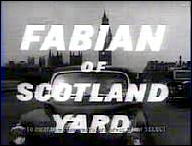
In truth, there was absolutely nothing astounding about the plots, save for their being based on real-life cases. But it was while emphasising the exploits of Detective Superintendent Fabian (during an era when people were defined by the superiority of their work) and the activities of Scotland Yard, it can be summed-up fairly as a good police procedural (for the mid-1950s) with actor-star Bruce Seton’s calm, perceptive doggedness leading the painstaking investigation work. In retrospect, perhaps more a measured film noir than a high-octane police thriller.
No sooner had it aired when the BBC received a complaint from Scotland Yard accusing the series’ producers of misrepresenting Metropolitan Police procedure as well as over dramatizing some events (apparently, it was the sadistic method used by the wife-murderer in the “Brides of the Fire” episode).
However, Fabian of the Yard made a big impact on 1950s British TV viewers, with series’ star Seton and the real-life Bob Fabian elevated to a god-like status. The series also scored financially via showings on NBC in 1955 (sometimes as Inspector Fabian of Scotland Yard) and as the syndicated Patrol Car. Two feature films (of re-edited episodes) were released to cinemas as Fabian of the Yard (in 1954) and Handcuffs, London (1955). The real Robert Fabian of the Yard died in June 1978 at the age of 77.
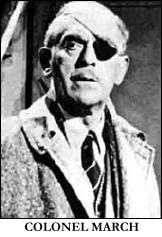
Other UK series attached to the theme of Scotland Yard, by title or through deed, included the atmospheric whodunit dramas of Colonel March of Scotland Yard (shown via ITV, 1955-56; syndicated in the US; produced circa 1952 and 1954). It was loosely based on the 1940 story collection The Department of Queer Complaints by John Dickson Carr (writing as Carter Dickson). The series featured an eye-patched Boris Karloff, a detective who concentrates on bizarre crimes.
Robert Beatty was a Canadian Mountie (a Detective Inspector) attached to Scotland Yard in Dial 999 (ITV, 1958-59) and solved various London-located crimes. (999, incidentally, is the UK police emergency number, similar to 911.) Man from Interpol (ITV, 1960-61) featured a special agent (played by Richard Wyler) from the Scotland Yard branch of Interpol. In 1961, a Scotland Yard operative, Det-Insp. Bollinger (Louis Hayward), and his police dog appeared as The Pursuers (ITV). Unfortunately, all were standard small-screen cops-and-robbers dramas.
Stryker of the Yard, with Clifford Evans (as Chief Inspector Robert Stryker), was a peculiar one. Apparently, it first appeared as a series of B-movies in British cinemas during the early 1950s. Then, they were re-edited and shown on NBC in 1957. As a TV series, it also showed up as half-hour episodes on UK’s Associated Television (ATV) from November 1961 to January 1962. A compilation film, Stryker of the Yard, was released in 1953.
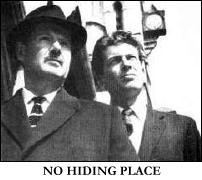
Perhaps the most popular (post-Fabian) Scotland Yard detective series of the 1950s (and 1960s) was No Hiding Place (ITV, 1959-67), featuring the crime-busting investigations of Chief Superintendent Lockhart (played with suitable bank manager authority by Raymond Francis). While this British ‘age of acquiescence’ continued to be ruled by the authority figures of Scotland Yard, it wasn’t too long before Lockhart replaced Fabian as the omnipotent one in the viewing nation’s hearts.
The series was oddly reminiscent of the Edgar Lustgarten Scotland Yard B-movies shown in the UK from around 1953, with detectives that looked like insurance salesmen constantly springing out of dark cars.
No Hiding Place evolved from two earlier series: The Murder Bag (ITV, 1957-59) and Crime Sheet (ITV, 1959), two police detective series also popular with 1950s UK viewers. In retrospect, however, No Hiding Place was a rather routine detective drama series, not always persuasive (though some robbery/murder scenes were quite convincing) and — apart from Francis’s dogged detective character — often uninteresting in performance. Plot-wise, coincidence was stretched almost to breaking point.
On a final but justly deserved Scotland Yard-related note, Gideon’s Way (ITV, 1964-66), based on the character and stories created by John Creasey (writing as J.J. Marric), was an uncommonly intelligent filmed drama series with John Gregson as Commander George Gideon. In many ways it may be regarded as the UK’s television equivalent to America’s excellent Naked City (hour series; ABC, 1960-63). In the former, London was the multi-shaded central character; the latter explored the unpredictable New York City.
Another significant element of the history of the TV Crime & Mystery was the Anthology series (now a long-forgotten small-screen form); its sometimes brilliant crime and mystery plays and its fine coterie of writers (teleplay or novel). Part 5 intends to look at this Theatre of Crime (ranging from Suspense to Kraft Mystery Theatre to The Short Stories of Conan Doyle).
Note: The introduction to this series of columns by Tise Vahimagi on TV mysteries and crime shows may be found here, followed by:
Part 1: Basic Characteristics (A Swift Overview)
Part 2.0: Evolution of the TV Genre (UK)
Part 2.1: Evolution of the TV Genre (US)
Part 3.0: Cold War Adventurers (The First Spy Cycle)
Part 3.1: Adventurers (Sleuths Without Portfolio).
June 27th, 2011 at 10:32 pm
Well, the anthology series isn’t Too forgotten…though currently the only one with new episodes I’m aware of is the criminous soft-porn series on Cinemax in the US, FEMMES FATALES (and about as bad as you might expect a soft-porn crime series on Cinemax to be). But within the last few years we’ve had MASTERS OF HORROR and its spin-offs MASTERS OF SCIENCE FICTION and FEAR ITSELF, and the Philadelphia-based low-budget sf series HEAVY SEDATION…though it has been a while since FALLEN ANGELS, much less POLICE STORY.
June 27th, 2011 at 11:01 pm
Steve–I know some of these productions are easily available on DVd, but I have been trying to find copies of The Pursuers. Any ideas…?
June 28th, 2011 at 12:06 am
Todd, you can add NBC’s LOVE BITES currently on Thursday night.
Anthology series are rare because it is difficult to build viewer’s weekly loyalty without regular characters for the viewer to get attached to. But like all dramatic formats, it will never totally disappear.
Barry, there is a near five minute excerpt of THE PURSUERS on YouTube search for the title:
THE PURSUERS (1961-62) THE FRAME LOUIS HAYWARD HONOR BLACKMAN
YouTube offers a free peek at old TV including old British series. At times you can see full episodes.
June 28th, 2011 at 2:43 am
WHOA , Tise, this is comprehensive ! Tons of old Goodies ,LOVE dragnet !
June 28th, 2011 at 5:16 am
Thanks, Michael…I’d been meaning to take a look at LOVE BITES, but haven’t yet.
Oh, and THE LINEUP is notable, at least in its original radio version, for being an early project of Blake Edwards as scripter.
June 28th, 2011 at 10:44 am
While not actually a police drama I saw the the season one, episode one of The Saint series last night on television. It originally aired on October 4, 1962. It, of course, starred Roger Moore and featured Shirley Eaton as a guess star. I also saw episodes of Highway Patrol and Sea Hunt a few weeks ago. I always enjoyed these three series.
June 29th, 2011 at 12:04 am
I’m surprised that M SQUAD isn’t mentioned. Lee Marvin’s lead performance remains riveting.
Surely it’s not because M SQUAD ran into 1960, given that it debuted in 1957 ?
June 29th, 2011 at 12:55 pm
To me, and I’m speaking for myself and not Tise, M SQUAD doesn’t have the “documentary” feel of DRAGNET, HIGHWAY PATROL and the other series in this column. Lt. Ballinger (Lee Marvin) is more of a lone wolf kind of character, not a solid, by-the-book Joe Friday.
While you’re right, that they’re both cop shows in the same black-and-white era, I wouldn’t otherwise say they have a lot in common — on opposite ends of the same spectrum, you might say. (Or at least I would.)
June 29th, 2011 at 1:48 pm
Just as AIRPLANE was a direct parody of the movie ZERO HOUR, so POLICE SQUAD was specifically spoofing M-SQUAD. Not only is the opening title music similar, but the bit where Marvin screeches the car to a halt, gets out and trades fire with an unseen assailant is exactly the same. Marvin’s character is called Frank, and he is working in a ‘special detail’ of the police force.
July 1st, 2011 at 4:35 am
Rick L. — Apologies for the delay in responding. The reason that I didn’t bring M SQUAD into the discussion about the ‘from the files of..’ series is that, as Steve rightly suggests, the series was outside the DRAGNET phase (based on the few episodes I’ve seen). It was a hard-nosed action fiction about a special Chicago police unit.
Although I feel that M SQUAD was clearly the better series, it was in its way closer to the police squad action of, say, THE DETECTIVES, STARRING ROBERT TAYLOR (ABC, 1959-61; later as ROBERT TAYLOR’S DETECTIVES, NBC, 1961-62) than the DRAGNET sub-division.
Actually, I feel that M SQUAD was revisited in the 1980s, perhaps, in the 1st season of Michael Mann’s CRIME STORY (NBC, 1986-88). Both were about a Chicago-based special police squad (with a fondness for machine-guns and pump-actions), with the Mann series even produced as a period piece (the early 1960s).
July 3rd, 2011 at 5:48 pm
[…] 3.0: Cold War Adventurers (The First Spy Cycle) Part 3.1: Adventurers (Sleuths Without Portfolio). Part 4.0: Themes and Strands (1950s Police Dramas). […]
September 5th, 2015 at 2:26 pm
The last ITV region to screen the now rare crime series called “Stryker of the Yard” was ATV (Midlands) in Autumn 1972 in a couple of late night slots. Channel TV screened all 15 episodes at an earlier slot during the same year. Where have all these film prints gone?